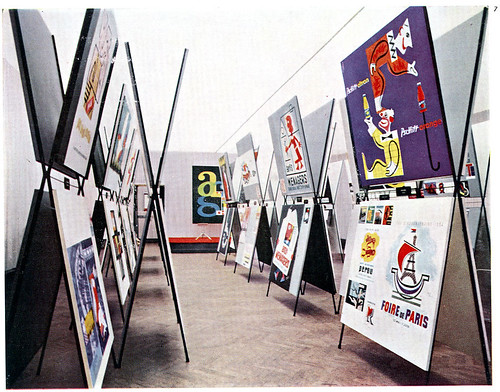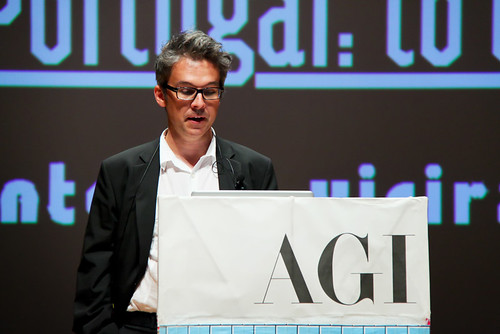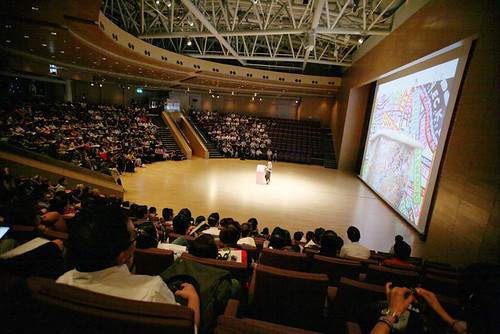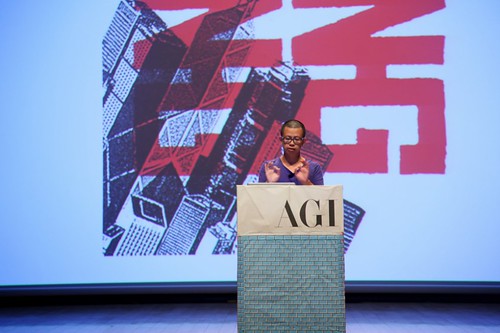Autumn 2013
The accessible elite
various designers
Paula Scher
Tony Brook
F. H. K. Henrion
Adrian Shaughnessey
Henryk Tomaszewski
Linda Kwon reports on a design conference that aims to fight the ‘velvet rope syndrome’
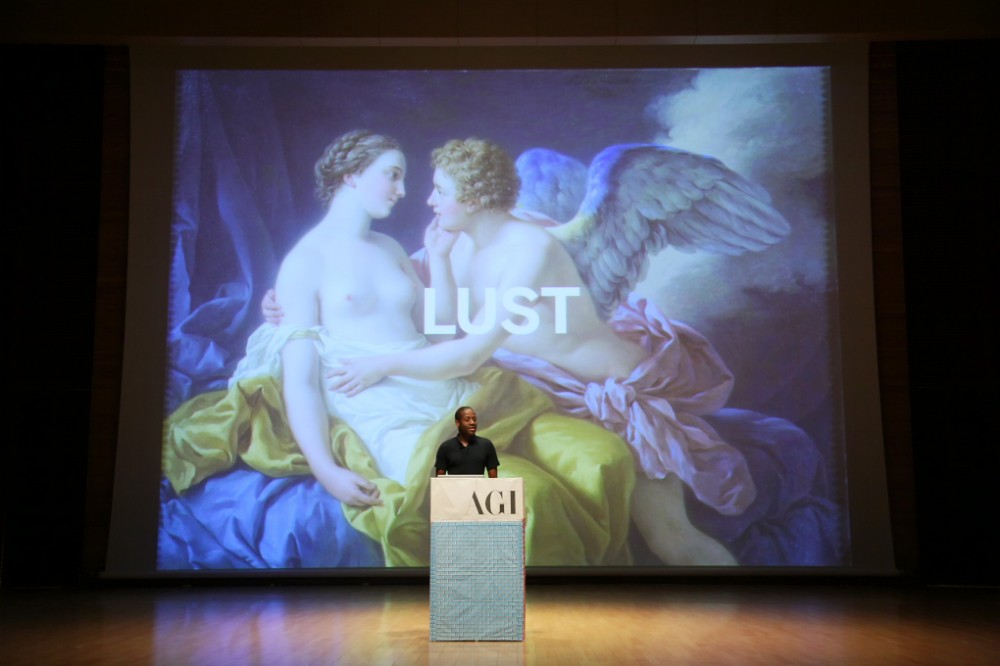
The student conference of the Alliance Graphique Internationale (AGI) takes place in London from 26-27 September 2013, right after the annual AGI Congress. The latter is a strictly private elite gathering of designers who meet in a different part of the world each year. By contrast, the AGI Open, as the former is known, aims to be as accessible as possible and to take advantage of having so many celebrated, international figures in one place.
The event sets out to differentiate itself from the standard design conference set-up by having a more interactive format which is fundamentally about sharing ideas and views – an approach that resonates with the times, but may surprise those who still regard AGI as irretrievably staid.
AGI was founded in the early 1950s by a small coterie of graphic artists. What began as a private club for the most renowned designers of the era – mainly European poster designers – has evolved through an invitation-only system: only those deemed to be ‘a person of influence and importance nationally and internationally’ are asked to join. This exclusive approach has ensured a slow growth over AGI’s history – from 65 to just over 600 members at present.
A glance at Idea magazine no. 22, which featured London’s 1956 AGI exhibition, gives a taste of the organisation’s impressive origins: participants included Henryk Tomaszewski, Bruno Munari, Otto Treumann, J. Müller-Brockmann, Jean Carlu (president), Hans Schleger (Zéro), Hiroshi Ohchi, Paul Rand, Lester Beall, Herbert Bayer and Leo Lionni. The AGI identity was designed by joint vice-president F. H. K. Henrion.
Display boards designed by F. H. K. Henrion in the AGI ‘Design in Advertising Exhibition’, held at the RBA Galleries, London, 14-30 June 1956. AGI poster designed by F. H. K. Henrion. Image from Idea vol. 4 no. 22, April 1957.
Top: Edward Opera (Pentagram) at AGI Open, Hong Kong, 2012. Photo: Wong Ka Hang.
The AGI has often been perceived as an ‘old boys’ club’ (a photo taken at Derek Birdsall’s Omnific studio in the late 1980s showed London AGI members posed as in Leonardo’s Last Supper) but the past two decades have seen a shift towards greater numbers of younger designers, women and non-Western designers in its ranks, and a change in the organisation’s approach. AGI’s ‘elite’ status is now counterbalanced by a desire to share the collective expertise of its membership.
AGI Open, the associated design and education conference, was conceived of as a way of opening up the organisation and giving something back to the wider design community of students and professionals. Each year AGI Open is held in a different country where the local chapter and organising team largely determines the structure and programme. The local chapter is encouraged to incorporate national characteristics into the conference, which in part explains this year’s theme: ‘Do you fancy coming to London for a nice cup of tea and a chat?’
The first AGI Open was held in 2010 in Porto, Portugal, with the theme ‘Process is the Project’, followed by Barcelona, Spain, in 2011 (‘What. How. Why.’) and last year in Hong Kong (‘Heaven and Hell’). The host city for 2014 will be São Paulo, Brazil.
As one might expect, the speakers are the primary attraction. Sarah June Fox, a designer based in Dublin, Ireland, who attended the Barcelona AGI Open in 2011 as a student, said that ‘the initial draw was to see designers that I knew prior to the event, “design rock stars” like Paula Scher, Lars Müller, Michael Bierut and Joost Grootens, who were all impressive to see [but] the real attraction, however, was in discovering new designers not known to me.’
Jolt in the arm
The conference can also serve as a way to bond with classmates and be a stimulating segue into the school year. ‘AGI Open was the perfect way to bond as a class while getting fired up about design leading into such a challenging year. It was perfect timing personally as I was just starting my final year in college. The ideas that were discussed, both in the conference, then over a few pints afterwards, were the ultimate stimuli to get back to college to work’, said Fox.
António Silveira Gomes at AGI Open, Hong Kong, 2012. Photos: Wong Ka Hang.
Andrew Campbell, graphics course leader at Norwich University of the Arts in the UK, describes the atmosphere: ‘That jolt in the arm that you get is amazing – that’s the excitement of design conferences rather than reading a book.’
Despite the buzz of seeing and hearing ‘star’ designers, the lack of interaction can be a downside. Garfield Chan, a project manager at the Hong Kong Federation of Design Associations, who was a project assistant for the AGI Open Hong Kong in 2012, said that ‘the interaction with the public was not enough, it would be better if the activities included workshops or a small design competition. I think the local designers and design students would like to have more chances to meet the international top designers.’
No hiding place
When it came to the planning and conceptualisation of this year’s AGI Open, there was the view among the AGI UK membership that the ‘old rigid lecture format’ had become outdated, prompting discussions about what a more interactive and relevant approach could involve.
‘The traditional conference format was getting a bit mouldy and no longer appropriate for the age of shared information,’ said Adrian Shaughnessy, designer, writer, publisher and senior tutor at the Royal College of Art, who also heads the education arm of the AGI Open organising committee.
The focus for this year’s AGI Open will be on what Shaughnessy calls ‘the three “D”s – discussion, discourse and debate.’ It will feature a mixed format including panel discussions, competitive debates and interviews to encourage greater interaction and a shared dialogue. Speakers will be expected to share their ideas and opinions rather than give the typical show-and-tell portfolio presentations. Shaughnessy described this departure from the typical design conference structure as ‘the conference format for the social media age’. The hope is that attendees will feel more engaged in an ongoing discussion rather than a passive exercise in admiration.
Paula Scher (see Eye 77) talks about her hand-drawn maps at AGI Open, Hong Kong, 2012.
Another key to the conference approach will be the accessibility of the speakers to attendees. ‘There will be no green room where speakers can hide away and eat smoked salmon sandwiches,’ said Shaughnessy. ‘At all times, speakers will be encouraged to mingle with the attendees … No one will be allowed to hide.’
There will also be the opportunity to buy design samples, posters and personal memorabilia from AGI members at a ‘jumble sale’, the proceeds of which will be donated to Moorfields Eye Hospital. There will also be a schedule of fringe events that will accommodate longer presentations and talks.
The venue for AGI Open, the Barbican Centre, will lend itself well to the theme. The centre’s open-plan space is spread over many levels, with nooks and crannies that the organisers hope will encourage intermingling. Although there hasn’t been a formal student advisory committee involved in the planning, there have been multiple streams of input from students, young designers, tutors and design educators. At the February launch announcing this year’s AGI Open (at London’s Design Museum), the reception was positive, with much discussion about different ways to get students involved.
Campbell, who attended the launch, emphasised the importance of including younger voices: ‘Besides simply receiving information, how do students think about what they’re learning and observing? He suggested that this could be explored at the conference via a written dialogue through something as simple as Post-It note discussion boards. This is another area in which educators could play a role, if they link talks and issues raised at the conference with readings and further discussion in the classroom.
London, as one of the great cities of design, has no shortage of design-related talks and events, the majority of which are of the customary ‘show and tell’ variety. Critical discussions about design are more often the purview of the educational realm. It could be interesting to consider the possibility of bridging an online or offline space for dialogue and exchange that could continue beyond the confines of an intensive conference.
Could AGI Open present an opportune moment to lay the foundations for such a space of exchange? Whether this might be a direct exchange between design schools, or an online student design community, informal or formal, there appear to be endless possibilities to pick up where AGI Open leaves off in 2013.
Eye is the world’s most beautiful and collectable graphic design journal, published quarterly for professional designers, students and anyone interested in critical, informed writing about graphic design and visual culture. It is available from all good design bookshops and online at the Eye shop, where you can buy subscriptions, back issues and single copies of the latest issue. Eye 86 is on press and will be available soon.

